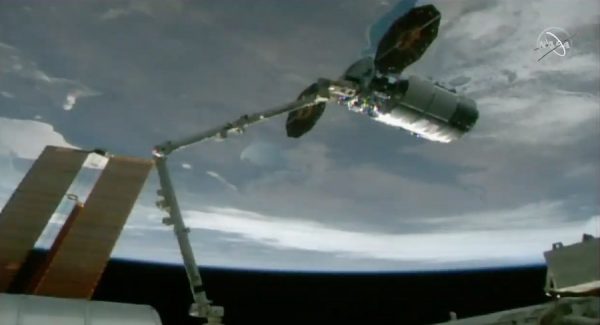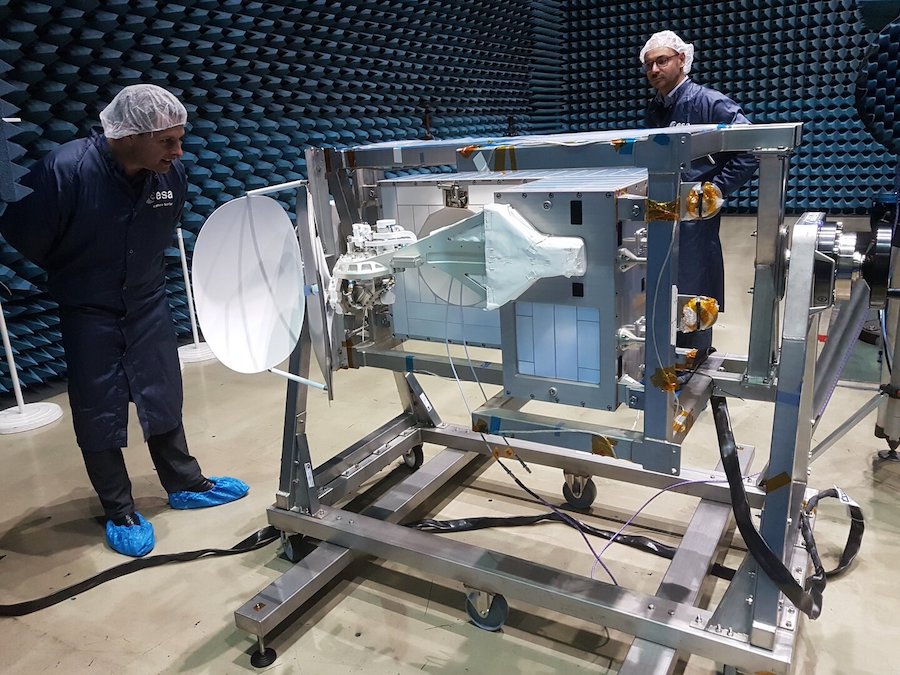Cygnus freighter delivers new British-made antenna to International Space Station – Spaceflight Now

A commercial Cygnus cargo freighter arrived at the International Space Station Tuesday two-and-a-half days after launching from Virginia’s Eastern Shore, delivering a new British-made high-speed communications antenna and more than 7,000 pounds of other experiments and equipment.
Astronaut Drew Morgan, working at a control station aboard the space station, used the research outposts’s Canadian-built robotic arm to capture the Cygnus spacecraft at 4:05 a.m. EST (0905 GMT) Tuesday while the cargo freighter hovered less than 40 feet (12 meters) below the complex.
Ground teams later took control of the robot arm to berth the Cygnus spacecraft to the Earth-facing port of the station’s Unity module, where it is scheduled to remain attached until May 11, then the ship will detach and depart. The freighter will perform a flame combustion experiment in orbit before re-entering the atmosphere and burning up, disposing of the space station’s trash.
The Northrop Grumman-owned spacecraft is named the S.S. Robert H. Lawrence, Jr., in honor of the first African American selected as an astronaut in a U.S. space program.
“Congratulations to the entire NASA and Northrop Grumman teams on another successful vehicle capture,” Morgan radioed from the space station. “The Cygnus NG-13 vehicle … is named in honor of U.S. Air Force Maj. Robert H. Lawrence, Jr., and as the first African American to be selected as an astronaut by a national space program, Robert defined possible against the odds when he was selected for the Air Force’s Manned Orbiting Laboratory project in 1967.”
Lawrence died in a training accident in 1967 before he flew in space, and the MOL program was canceled by the military in 1969.
“It’s our honor to welcome the S.S. Robert H. Lawrence, Jr., aboard the ISS,” Morgan said.
The S.S. Robert H. Lawrence launched Saturday from Wallops Island, Virginia, on top of a Northrop Grumman Antares rocket. The mission marks the 13th resupply flight to the space station by Northrop Grumman under two multibillion-dollar commercial cargo transportation contracts with NASA.
Astronauts planned to open hatches and begin unpacking the 7.445 pounds (3,377 kilograms) of cargo inside the Cygnus freighter’s pressurized module, made in Italy by Thales Alenia Space.
One of the items stowed inside is a new communications antenna developed by the European Space Agency to be installed on a spacewalk later this year outside the station’s European Columbus lab module.
The new antenna will transmit and receive data in Ka-band, allowing data transfer speeds as fast 50 megabits per second for a downlink and 2 megabits per second for uplink, according to ESA.

Called ColKa — short for Columbus Ka-band antenna — the new addition to the space station will allow European scientists higher data downlink and uplink speeds without relying in busy U.S. Tracking and Data Relay Satellites. The new system will also be able to transfer high-definition video between the space station and Earth.
ESA is building out its own satellite data relay network called EDRS. Two EDRS relay nodes launched into geostationary orbit more than 22,000 miles (nearly 36,000 kilometers) over the equator in 2016 and 2019, providing near-global coverage.
The EDRS satellites will beam the data relayed from the space station to a ground site in Harwell, England, for dissemination to the Columbus control center in Germany and science teams across Europe.
The antenna was built by MDA Space and Robotics Ltd. in the United Kingdom.
“This is the first major industrial contribution from the UK to the ISS, and it will revolutionize the ability of scientists in the UK and Europe to access the results of their experiments,” said Graham Turnock, CEO of the UK Space Agency. “This is yet another example of the UK economy benefiting, through investment, jobs and new skills, from our continued collaboration with the European Space Agency.”
Officials say the ColKa antenna is a pathfinder for further ESA space communications projects, such as a deep space data relay antenna that could be mounted on the NASA-led Gateway station in lunar orbit.
Other payloads delivered to the station Tuesday by the Cygnus spacecraft include biological experiments and three small satellites sponsored by the U.S. military and NASA.
Here’s a breakdown of the cargo manifest provided by NASA:
- 3,501 pounds (1,588 kilograms) of vehicle hardware
- 2,129 pounds (966 kilograms) of scientific investigations
- 1,570 pounds (712 kilograms) of crew supplies
- 179 pounds (81 kilograms) of spacewalk equipment
- 66 pounds (30 kilograms) of computer resources
A scanning electron microscope built by Voxa, a Seattle-area company that aims to miniaturize and reduce the cost of nano-imaging technology, was among the items packed aboard the Cygnus spacecraft.
Electron microscopes work by scanning electron beams over a target to create an image, telling scientists about the material’s physical characteristics and composition. A conventional scanning electron microscope can cost $1 million.
Christopher Own, facility manager and CEO of Voxa, says his company’s unit costs around $65,000, and the price could come down if it is mass-produced.
NASA wants to test the Mochii microscope, named for the Japanese dessert, in orbit to see if the device could help scientists analyze biological samples, perform materials science experiments, and take detailed pictures of contaminants and particles that could affect the performance of equipment aboard the space station.
It sometimes takes months to get a sample back to Earth for analysis in ground-based labs. SpaceX’s Dragon capsule is the only vehicle capable of returning large amounts of cargo to the ground intact.
A microscope like the Mochii device on the space station could allow scientists to analyze samples soon after they are gathered. What’s more, the microscope can be operated remotely by researchers on the ground.
“When we came up with the concept, we thought what about the dessert mochii,” Own said. “It’s small, cute and absolutely delicious. Everybody will want one.”
Astronauts will install the microscope inside the Japanese Kibo laboratory module on the space station, and the device will go through testing to see if it meets specifications.
“The expectation, provided that the experiments are successful up there, is to leave it up there and give it to the wider community to use,” Own said.
Fresh fruit, vegetables and cheese were also loaded into refrigerators on the Cygnus spacecraft for the trek to the space station.
Small satellites hitch ride to space on Cygnus
Three small satellites are hitched a ride to the International Space Station aboard the Cygnus supply ship.
Two of the miniature spacecraft are sponsored by the Defense Advanced Research Projects Agency, or DARPA. Another was developed at NASA’s Ames Research Center in California.
The Red-Eye 2 microsatellite is the second in a series of Red-Eye satellites developed by DARPA. The Red-Eye satellites aim “to develop and demonstrate technologies that increase the utility of low-cost microsatellites,” according to NASA.
The first Red-Eye satellite launched to the station aboard a SpaceX Dragon cargo ship last year, then was released from the NanoRacks Kaber deployer in June 2019.
“Red-Eye will demonstrate lightweight, low-power, gimballed inter-satellite communications links appropriate for the class of satellites approximately 100 kg (220 pounds) in size,” NASA wrote in a summary of the experiment. “Red-Eye will also demonstrate new attitude control components, onboard processors, and software-defined radios.”
Two CubeSat-class satellites are also aboard the Cygnus supply ship for release from the space station’s smaller satellite deployer.
The Deformable Mirror, or DeMi, spacecraft is about the size of a small suitcase. Developed at the Massachusetts Institute of Technology, the deformable mirror instrument will demonstrate technologies that could be used on future space telescopes making high-contrast observations of exoplanets around bright stars. Such precision observations, which will use coronagraphs to blot out the light of the star, require the use of deformable mirrors inside the telescope that can be adjusted using internal actuators, according to MIT.
The deformable mirrors “can correct image plane aberrations and speckles caused by imperfections, thermal distortions, and diffraction in the telescope and optics that would otherwise corrupt the wavefront and allow leaking starlight to contaminate coronagraphic images,” MIT scientists wrote in a summary of the demonstration.
DARPA is funding the DeMi experiment, and Aurora Flight Sciences is managing the mission.
NASA’s TechEdSat 10 nanosatellite is the next in a line of experimental CubeSats developed at the Ames Research Center in California. According to NASA, the TechEdSat 10 spacecraft will function as a high temperature, accurate deorbit reentry nanosatellite.
Email the author.
Follow Stephen Clark on Twitter: @StephenClark1.






